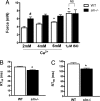Ablation of sarcolipin enhances sarcoplasmic reticulum calcium transport and atrial contractility
- PMID: 17971438
- PMCID: PMC2077025
- DOI: 10.1073/pnas.0707722104
Ablation of sarcolipin enhances sarcoplasmic reticulum calcium transport and atrial contractility
Abstract
Sarcolipin is a novel regulator of cardiac sarcoplasmic reticulum Ca2+ ATPase 2a (SERCA2a) and is expressed abundantly in atria. In this study we investigated the physiological significance of sarcolipin in the heart by generating a mouse model deficient for sarcolipin. The sarcolipin-null mice do not show any developmental abnormalities or any cardiac pathology. The absence of sarcolipin does not modify the expression level of other Ca2+ handling proteins, in particular phospholamban, and its phosphorylation status. Calcium uptake studies revealed that, in the atria, ablation of sarcolipin resulted in an increase in the affinity of the SERCA pump for Ca2+ and the maximum velocity of Ca2+ uptake rates. An important finding is that ablation of sarcolipin resulted in an increase in atrial Ca2+ transient amplitudes, and this resulted in enhanced atrial contractility. Furthermore, atria from sarcolipin-null mice showed a blunted response to isoproterenol stimulation, implicating sarcolipin as a mediator of beta-adrenergic responses in atria. Our study documented that sarcolipin is a key regulator of SERCA2a in atria. Importantly, our data demonstrate the existence of distinct modulators for the SERCA pump in the atria and ventricles.
Conflict of interest statement
The authors declare no conflict of interest.
Figures





References
-
- Odermatt A, Taschner PE, Scherer SW, Beatty B, Khanna VK, Cornblath DR, Chaudhry V, Yee WC, Schrank B, Karpati G, et al. Genomics. 1997;45:541–553. - PubMed
-
- Minamisawa S, Wang Y, Chen J, Ishikawa Y, Chien KR, Matsuoka R. J Biol Chem. 2003;278:9570–9575. - PubMed
-
- Babu GJ, Zheng Z, Natarajan P, Wheeler D, Janssen PM, Periasamy M. Cardiovasc Res. 2005;65:177–186. - PubMed
Publication types
MeSH terms
Substances
Grants and funding
LinkOut - more resources
Full Text Sources
Molecular Biology Databases
Miscellaneous

